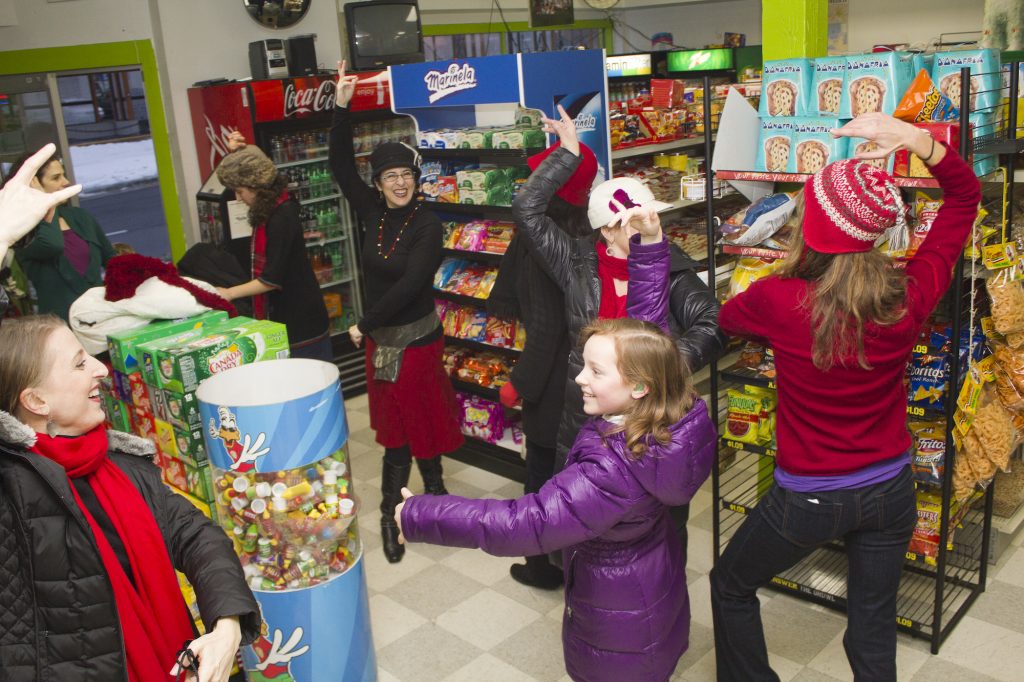Irrigate: Turning a huge Twin Cities construction project into an opportunity
Though the new Green Line light rail line would finally connect the Twin Cities of Minneapolis and St. Paul with rail transit, business owners, local leaders, and advocates raised red flags about construction disrupting the corridor’s businesses as well as immigrant and communities of color. To mitigate these negative effects, Springboard for the Arts and other local organizations created a series of artistic interventions that did more than merely prevent painful disruptions; they helped the corridor thrive during a period of vulnerability.

Relight the Victoria by artist Nick Clausen. Photos courtesy of Springboard for the Arts, shared by Jun-Li.
This feature is part of arts and culture month at T4America, where we’re sharing a handful of stories about how arts and culture are a vital part of building better transportation projects and stronger communities. This feature is adapted from a longer case study featured in T4America’s and ArtPlace America’s upcoming field scan on arts, culture and transportation due to be released next Wednesday, September 27. Sign up for our new Arts & Culture email list to be notified first.
The Twin Cities of Minneapolis and St. Paul have long been culturally, economically, and geographically linked, but until 2014 they lacked a meaningful, modern rail connection. The Green Line, originally known as the Central Corridor, was a new light rail line planned to run primarily along University Avenue between Minneapolis and St. Pau The area is home to a large number of immigrants and communities of color, and already has a painful history of disconnection and displacement from the construction of I-94 right through the middle of many of the same neighborhood decades ago.
With a disruptive construction project planned, civic leaders feared that months of negative press, dust, and noise might bankrupt businesses and lead to a black eye for the project before it ever opened.
In response to this concern, Springboard for the Arts, a nationally recognized community and economic development organization based in St. Paul, the Twin Cities Local Initiatives Support Coalition, and the City of St. Paul created Irrigate, a “community development strategy that mobilizes the skills and creativity of local artists to create innovative, meaningful, authentic solutions to local challenges.”

Irrigate photos courtesy of Springboard for the Arts, shared by Jun-Li.
Springboard trained 600 artists from the neighborhoods around the rail line to collaborate with businesses and organizations along University Avenue. A total of 220 artists completed 150 creative placemaking projects over 36 months that were designed bring attention, customers, joy and beauty to the spaces and businesses adjacent to the construction. Irrigate projects included musical and theatrical performances in businesses, artistic installations in construction fencing, dance workshops, interactive musical benches, murals, street theatre and performances, and much more.

Flamenco Christmas on the Green Line: A Processional of Song and Dance by Deborah Elias. Photo by Rudy Arnold.
These projects completely changed the narrative about the long construction project and transformed the coverage. They generated more than 51 million positive earned media impressions, which spread stories about the people, neighborhoods and businesses sharing University Avenue and helped to connect new and old customers to the businesses during construction. As Nancy Homans, Policy Director for the City of St. Paul explained,
While the City of Saint Paul tried feverishly to garner positive coverage for the benefits of transit that the Central Corridor would bring to the community, their positive message was consistently diluted in the media by negative stories about the impact of construction. As Irrigate projects began popping up along the Corridor…the magic of art started a different conversation. Irrigate’s public process engaging artists from the community to support local businesses provided a nimble and creative way to influence the narrative and change community perceptions of the value of community development.
Businesses reported that Irrigate projects helped them maintain visibility and reach new customers, and Springboard felt that the project helped to change the narrative of the corridor, build social capital among neighbors and businesses, and increase the prosperity of small businesses in the corridor. Ultimately, when opening day arrived, the mood was one of celebration, instead of just relief after enduring the collateral damage that would have come from a painful construction process.

Opening day on the Green Line. Flickr photo by Michael Hicks. https://www.flickr.com/photos/mulad/14238058898/
As with many of their successful projects, Springboard published a toolkit for communities who want guidance on running a similar program during construction. Irrigate has also been featured on ArtPlace’s website, in a documentary video, and in T4A’s Scenic Route Guide.
—
This project is one of the many case studies that will be featured in Transportation for America’s upcoming field scan on arts, culture and transportation, commissioned by ArtPlace America, to be released next Wednesday, September 27. The field scan is intended to examine the ways in which transportation professionals are exploring new creative, collaborative and contextually-specific approaches to engage the community in more inclusive processes for planning and building new transportation projects.
Stay tuned for more about arts and culture during the rest of September.



















